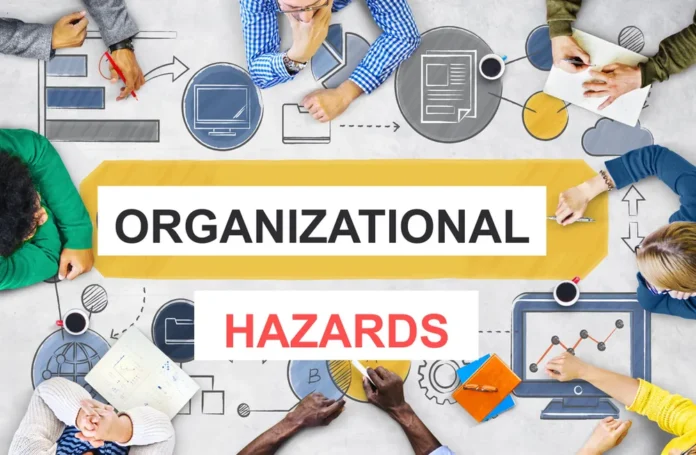No workplace is free from hazards, but the question is: how do you recognize the ones that can potentially harm workers?
Well, one of the primary causes of workplace illnesses, injuries, and incidents is the failure to recognize and identify hazards that are not only present but could have been anticipated earlier. In fact, a critical element of every effective health and safety program is an ongoing, proactive process to assess and identify such hazards. It is the only way to be better prepared to eliminate or control them and prevent injuries, accidents, downtime, and property damage.
While it is the responsibility of every employer to carry out a thorough risk assessment and document it to prevent unfortunate incidents, in this article, we will discuss the five common health and safety hazards in the workplace that you must recognize to keep yourself protected.
1. Exposure to Harmful Substances

In many workplaces, it is common for workers to get exposed to various harmful substances, which can harm their overall health. Some of the most commonly found substances in varying forms include dust, chemicals, fumes, or even biological agents, exposure of which can occur through skin contact, inhalation, injection, or ingestion.
For instance, one such example is exposure to asbestos, a naturally occurring mineral commonly found in workplaces due to its wide use in industries. Also, workers in shipbuilding, manufacturing, construction, and other trades are frequently exposed to asbestos fibers, which may not affect instantly but, over time, result in chronic health conditions, including mesothelioma. Thus, if you have been exposed to these harmful substances, you need to seek legal assistance from a reputed firm like www.lawfirm.com right away to receive your rightful compensation for the treatment.
However, it is also the responsibility of employers to prioritize workers’ safety and create awareness about harmful substance abuse by implementing proper precautions to ensure a safer and healthier work environment.
2. Ergonomic Hazards
This type of hazard occurs when the body positions, work type, and working conditions constantly strain your overall body. While these hazards are the toughest to recognize, it always takes time before you can actually notice the strain or the harm posed by these hazards.
For instance, in ergonomics hazards, short-term exposure often leads to tender muscles the following day or even the weeks following the strain. However, extended exposure may lead to serious long-term or permanent issues. Some of the most common ergonomic hazards include improper workstations and chairs, awkward movements, frequent lifting, wrong posture, using too much force frequently, or even excessive vibration.
However, many types of ergonomic equipment are available to prevent these issues, such as chairs, desks, or computer keyboards, which can help you avoid these types of injuries. Also, identifying these risks is the first step toward mitigating them.
3. Physical Hazards

Environmental or physical hazards are risks from within the environment that can significantly harm your body without necessarily touching it. Also, these hazards are more commonly found in specific industries than others, such as professionals who usually work outdoors are more prone to weather-related exposure.
However, these hazards are increasingly unpredictable and constantly changing, let alone being out of control most of the time. After all, you can only predict so much with meteorological advances and seasonal changes regarding weather hazards and challenges. Some common examples of physical hazards include:
- Dangerous noise levels
- Extreme temperatures
- Dangerous levels of radiation
- Extreme precipitation
- Unstable infrastructure
- Pollution
- Biological hazards
- Violent members of the public
However, the only way to avoid these hazards is first to recognize the signs and then use the right protective gear, like earplugs for noise or radiation-detecting badges, let alone enroll in training programs to stay aware of them.
4. Biological Hazards
These types of hazards are usually associated with working with animals, people, or infectious plant materials and may pose a unique risk to the health and safety of workers. Workers most commonly at risk of biological hazards include the ones working in daycare facilities, schools, nursing homes, universities and colleges, laboratories, emergency response, hospitals, and outdoor occupations.
Also, the most common types of biological hazards include exposure to pathogens like fungi, viruses, bacteria, or parasites and contact with infectious diseases through contact with contaminated surfaces, patients, or body fluids. Similarly, people who work with animal products or animals, such as veterinarians or livestock farmers, are at a high risk of zoonotic diseases. Moreover, these hazards may also result from exposure to different biological materials like toxins, allergens, and bio hazardous waste.
However, to mitigate this hazard, employers must prioritize preventive measures such as implementing strict hygiene practices, ensuring proper ventilation, providing appropriate personal protective equipment, promoting disposal practices, and proper waste management.
5. Organizational Hazards

While most workers fail to recognize it as a hazard, organizational or work organization stress refers to the stressors that come from the workplace’s processes, structure, and demands. According to the Health and Safety Executive, almost 11 million days are usually lost at work per year due to stress at work.
Work organization hazards can create long-term as well as short-term effects and are usually associated with various workplace issues like lack of respect, control, or workload. Some of the most common examples include high pace or intensity, workload demands, flexibility, workplace violence, social relations or support, respect, and sexual harassment.
The hazard may also stem from poor work-life balance or an imbalance between personal and professional life commitments. Therefore, employers have a huge responsibility, let alone a legal duty, to protect their workers from this hazard by ensuring risk assessment while acting on it with stress management.
They should implement measures that promote a healthy and supportive work environment. Moreover, they should encourage open communication, listening to employee feedback, and addressing their concerns to promote employee well-being while reducing work organization stress.
The Final Words
The five most common workplace hazards discussed in this article are by no means an exhaustive list. In fact, many other similar hazards may not only exist in your workplace but may put you at high risk of falling for them. Therefore, it is important to be vigilant in spotting these hazards while being aware of them. Remember, only through understanding and addressing these hazards can you maintain a safe and healthy work environment and go a long way in mitigating workplace hazards. Good luck!






